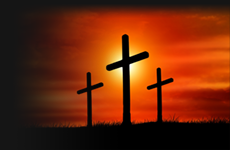Jesus' Crucifixion In Art
The symbol of Christ on the cross has infiltrated culture in innumerable ways, and depictions have become ubiquitous. There is no other subject matter that better reflects the historical progression of artistic expression. This is fitting, as there is no other event that has had comparable effect on all aspects of human history.

"The Crucifixion: Isenheim Altarpiece"
Artist: Matthias Grünewald
1512-16
Painting
This painting’s composition is dominated by the body of Christ hanging from a crucifix placed unusually close to the ground. His body is taut and entirely covered in lacerations and blistering spots of pox (some containing small thorns). His fingers are extended in agony. His feet, which are nailed to a projection on the crucifix, are horrifically distorted. He is the epitome of physical suffering, and he looks to have died on the cross. The left side of the painting features three mourning figures: a kneeling Mary Magdalene, and a swooning Virgin Mary supported by St John the Evangelist. Mary Magdalene’s hands are clasped in an ardent gesture of desperation and distress. On the right, the figure of St John the Baptist points calmly towards the body of Christ and holds a Bible. A red inscription reads: “he must increase, but I must decrease”. St. John the Baptist is accompanied by a lamb with a cross that is bleeding from a wound in his chest; the lamb both an attribute the Baptist and a recognised Eucharistic symbol of Christ and his passion.
This Oil on wood is in the Unterlinden Museum at Colmar, Alsace, France

"The Crucifixion and Christs's Death: Longinus Piercing Christ's Side"
Artist: Jan Provoost
1514
Painting
Longinus is the name given to the unnamed Roman soldier who pierced the side of Jesus with a lance; who in medieval and some modern Christian traditions is described as a convert to Christianity. His name first appeared in the apocryphal Gospel of Nicodemus. The lance is called in Christianity the "Holy Lance" (lancea) and the story is related in the Gospel of John during the Crucifixion. This act is said to have created the last of the Five Holy Wounds of Christ.
This oil on panel measures height: 117 cm (46 in) ; width: 172.5 cm (67.9 in) and is housed in the Groeningemuseum Musea in Bruges, Belgium
This painting is oil on canvas,measures 117 x 172.5 cms | 46 x 67 3/4 ins and is housed in the Groeninge Museum in
Brugge, Belgium.
- page 14 of 38 -
